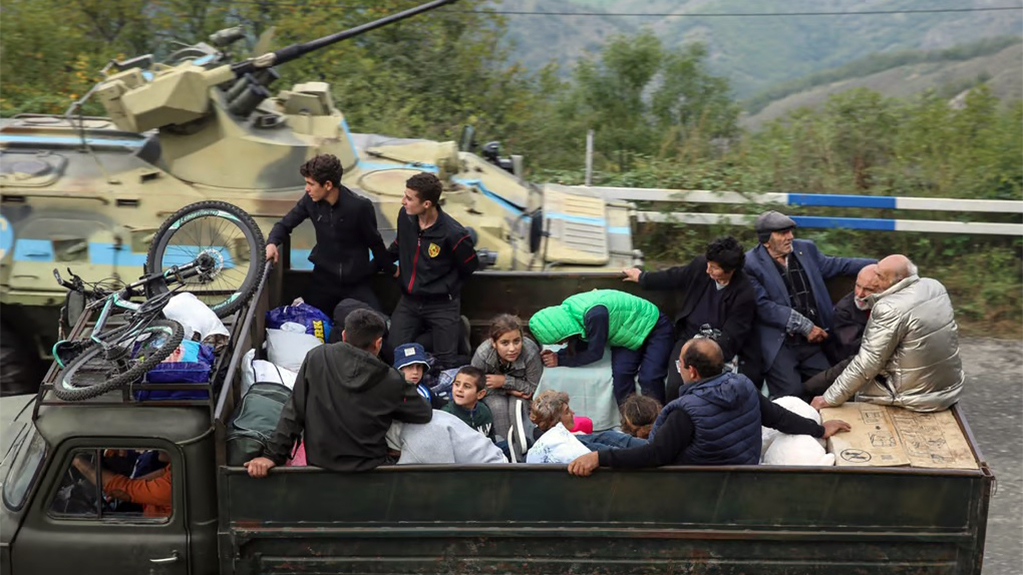According to data from the Armenian government, by the morning of September 28, the number of internally displaced persons from Nagorno-Karabakh exceeded 66 thousand. Ethnic Armenians are fleeing the region after Azerbaijan announced the restoration of sovereignty as a result of the military operation carried out on September 19-20.
News
Trending stories
- 1 BBC investigation: WWI–Era Chemical Weapons Used to Disperse Tbilisi Protests
- 2 Starting in 2026, First-Year Students at Private Universities Will No Longer Receive State Grants
- 3 NGOs Demand Answers on Which Chemical Substances MIA Used Against Protesters
- 4 Zurabishvili Appeals to International Organisations to Investigate Possible Use of “Camite”
- 5 Kobakhidze and Putin Attend International Forum on Neutrality in Turkmenistan
- 6 The Strasbourg Court Has Begun the Substantive Hearing of Gela Mtivlishvili's Case
A traffic jam several kilometers long has formed between Stepanakert city of Nagorno-Karabakh to the Armenian border. Citizens need a day, in many cases longer, to reach the crossing point opened in Kornidzor village on the Armenian border from Karabakh.
‘’12 members of our family traveled 18 hours in this car. My children and nephews are with us. They gave us gasoline in Stepanakert and we left without bringing anything with us. No one checked us at the border, they just counted us,’’ says a man from Karabakh who reached the Armenian city of Goris by truck and is awaiting asylum.
Hayk Ghazaryan, the Karabakh reporter of the CivilNet news agency, writes that chaos broke out in Stephanakert - part of the population from small communities has already been evacuated, and the rest of the people are waiting in line in the city because they were promised that they will be transported by buses.
‘’Most of the officials have gone to Armenia, law enforcement agencies are not functioning. There are people who are not burying their relatives, they are taking the bodies to Armenia,’’ says the journalist.
In total, 120 thousand people lived in Karabakh. The main problem of the refugees is housing. Displaced families often refuse to settle in regions and villages bordering Azerbaijan.
According to Nazeli Baghdasaryan, the press secretary of the Prime Minister of Armenia, the state has provided households for about 5,700 people. Most of the internally displaced people move in to live with their relatives.
Yesterday, news broke that the Azerbaijani authorities arrested the former state minister of the unrecognized Republic of Nagorno-Karabakh, billionaire Ruben Vardanyan, who was fleeing Nagorno-Karabakh through the Lachin corridor connecting to Armenia. Vardanyan moved to Karabakh in September 2022, renounced his Russian citizenship, and in November was appointed the state minister of the unrecognized republic. He worked chaired this position until the end of February 2023. Baku was demanding that he leave Karabakh.
In defense of Ruben Vardanyan, the Armenian government applied to the European Court of Human Rights a few hours after his arrest and requested Baku to provide information on the location and condition of the detainee.
As reported by the State Security Service of Azerbaijan today, Vardanian is accused of financing terrorism, participating in the creation and activities of an illegal armed formation, and illegally crossing the state border of Azerbaijan.

Today, September 28, the president of the unrecognized republic, Samvel Shahramanyan, signed an order by which all ‘’state institutions and organizations’’ will be dissolved by January 1, 2024, and the ‘’Republic of Nagorno-Karabakh’’ (Artsakh) will cease to exist. According to the second paragraph of the order, the population of Karabakh, including those who are currently outside its borders, should familiarize themselves with the terms of reintegration presented by Azerbaijan and decide independently and individually whether to stay in Karabakh.
International law considers the territory of Nagorno-Karabakh part of Azerbaijan. Ethnic Armenians mainly populate the region. During the Soviet rule, the Karabakh region was transformed into an autonomous district. In 1988, the people of Karabakh wanted Karabakh to be transferred from Soviet Azerbaijan to Soviet Armenia. The conflict escalated into a full-scale war in the early 1990s. The hostilities continued until 1994, and eventually, the region came under the control of the local Armenians, who declared independence on the territory of Karabakh. The Republic of Karabakh was not recognized by any country, including Armenia. In the fall of 2020, the renewed military conflict between Armenia and Azerbaijan, in which 7,000 soldiers and 170 civilians were killed, ended with a cease-fire agreement mediated by Russia. Baku regained control over a significant part of Nagorno-Karabakh and its surrounding territories. According to the agreement, Russian soldiers were deployed as peacekeepers in the Karabakh region.















